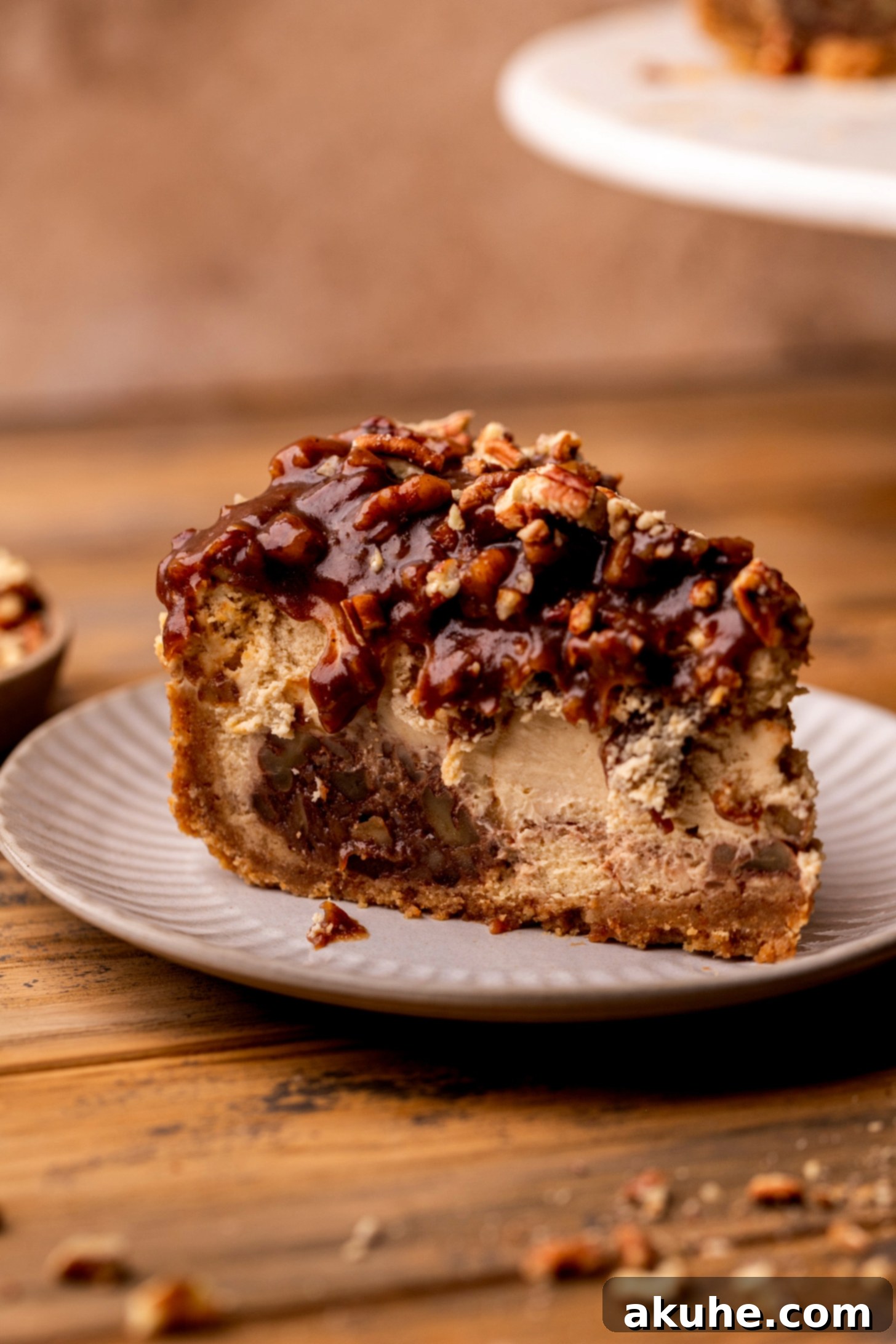Welcome to the ultimate dessert experience: the Pecan Pie Cheesecake. This isn’t just a dessert; it’s a culinary masterpiece that seamlessly blends the rich, comforting flavors of classic pecan pie with the smooth, decadent creaminess of a perfectly baked cheesecake. Imagine a crunchy graham cracker crust providing the perfect foundation, a luscious brown sugar cheesecake infused with a delicate cinnamon spice, and then, the star of the show: a generous swirl of sticky, sweet pecan pie filling baked right into the cheesecake itself. Topped with even more cinnamon-spiced pecans, this dessert offers an extraordinary textural and flavor journey that will leave a lasting impression on anyone who tries it.
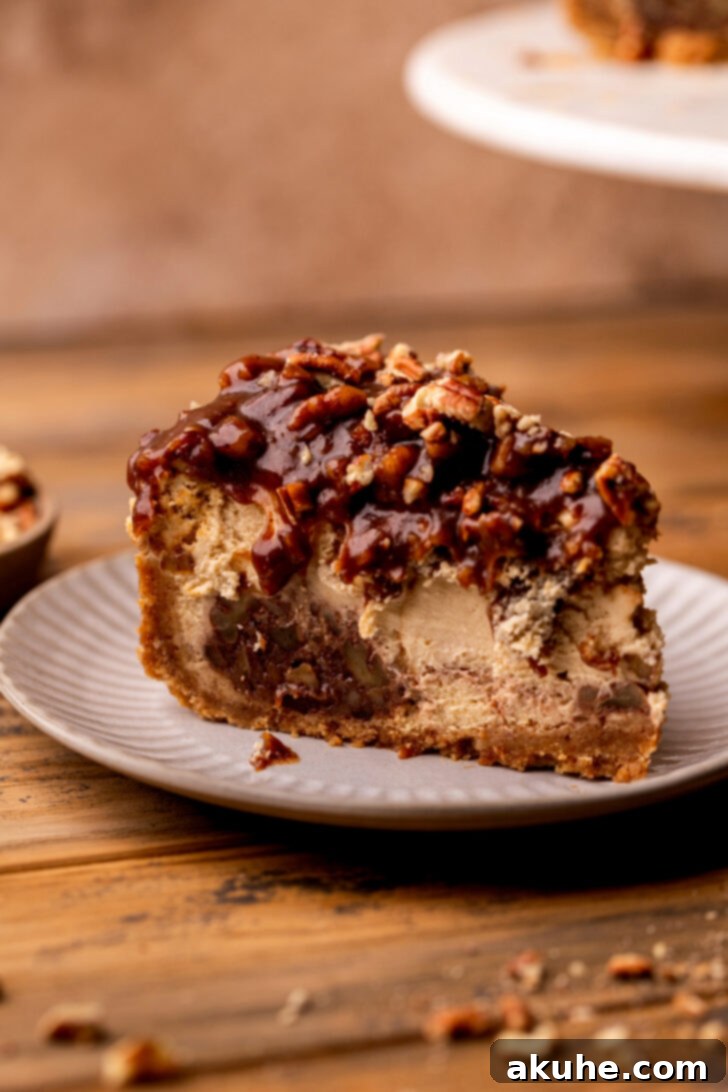
This Pecan Pie Cheesecake truly represents a magnificent upgrade from your traditional pecan pie. While a classic pecan pie is beloved, this hybrid creation elevates the experience to an entirely new level of sophistication and indulgence. It’s the ideal showstopper dessert, guaranteed to impress your family and guests, especially after a grand meal like Thanksgiving dinner. If your loved ones appreciate both the rich, nutty notes of pecan pie and the silky texture of a classic cheesecake, then this recipe is an absolute winner. It’s more than just a dessert; it’s an unforgettable culinary event, perfectly balancing familiar comfort with elevated elegance.
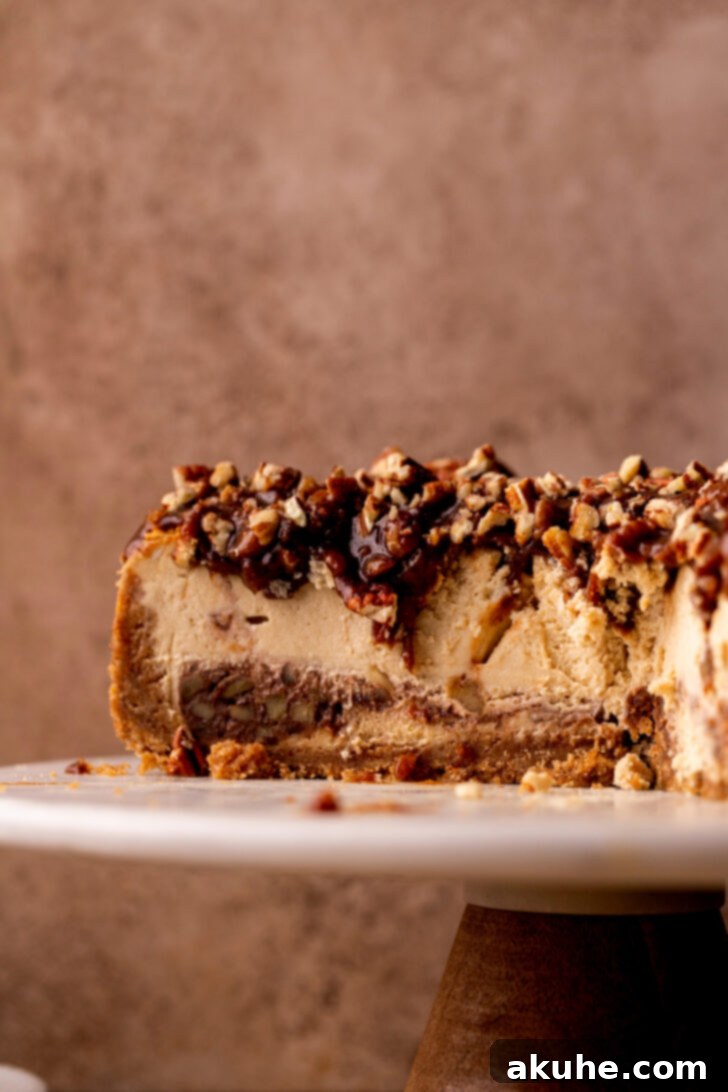
Crafting the Perfect Pecan Pie Cheesecake: Essential Tips
Achieving a flawless, crack-free, and incredibly moist cheesecake requires attention to detail. Follow these expert tips to ensure your Pecan Pie Cheesecake turns out just as stunning and delicious as this recipe promises:
- Tip 1: Prepare the Pecan Pie Filling in Advance for Optimal Texture. The pecan pie filling is a crucial component that adds depth and classic flavor. You have the flexibility to prepare this filling ahead of time, even as your graham cracker crust bakes. When cooking the filling, ensure it bubbles gently for 4-5 minutes. While it might appear quite liquidy when hot, don’t worry! This is normal. It will thicken considerably as it cools, developing that signature gooey, rich consistency that’s essential for both swirling into the cheesecake batter and for the luscious topping. Allowing it to cool properly before incorporating it ensures it holds its swirl beautifully within the cheesecake.
- Tip 2: Mastering the Art of Mixing Eggs for a Smooth Cheesecake. When it’s time to add the eggs to your cheesecake batter, precision is key. Always mix them in on the lowest speed possible, and only until they are just combined. Overmixing the eggs introduces too much air into the batter. As the cheesecake bakes, this excess air expands rapidly, creating large bubbles that rise and eventually pop. This phenomenon is a primary culprit behind unsightly cracks on the surface of your otherwise perfect cheesecake. Gentle mixing ensures a dense, creamy, and smooth texture.
- Tip 3: The Indispensable Water Bath for a Flawless Finish. A water bath (bain-marie) is your best friend when baking cheesecakes, and it’s absolutely essential for preventing cracks and achieving that characteristic moist, silky-smooth texture. The gentle, even heat from the water bath helps the cheesecake bake slowly and uniformly, preventing the edges from cooking too quickly and drying out before the center is set. I highly recommend using a large roasting pan (a standard 12×16 inch pan works wonderfully) and placing your 9-inch springform pan inside a slightly larger 10-inch cake pan. This acts as an extra barrier, completely safeguarding your cheesecake from any water seeping in while still providing the benefits of the water bath. Fill the roasting pan with hot boiling water until it reaches about two-thirds up the side of the 10-inch cake pan. This method is superior for guaranteeing no water ingress and achieving a perfect bake.
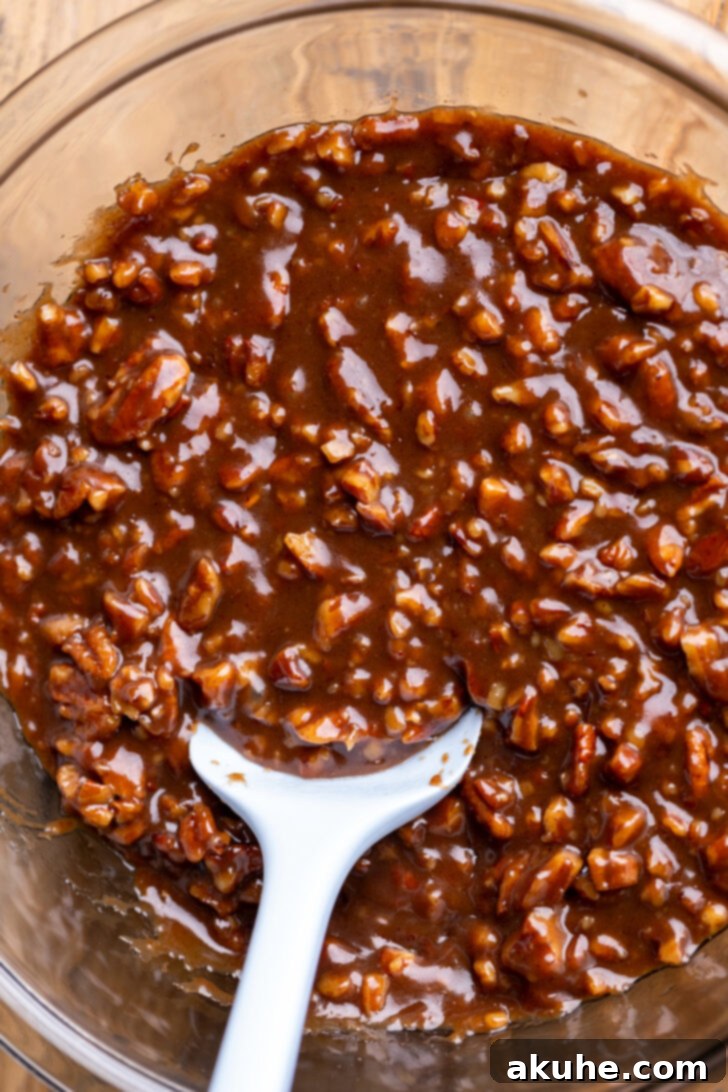
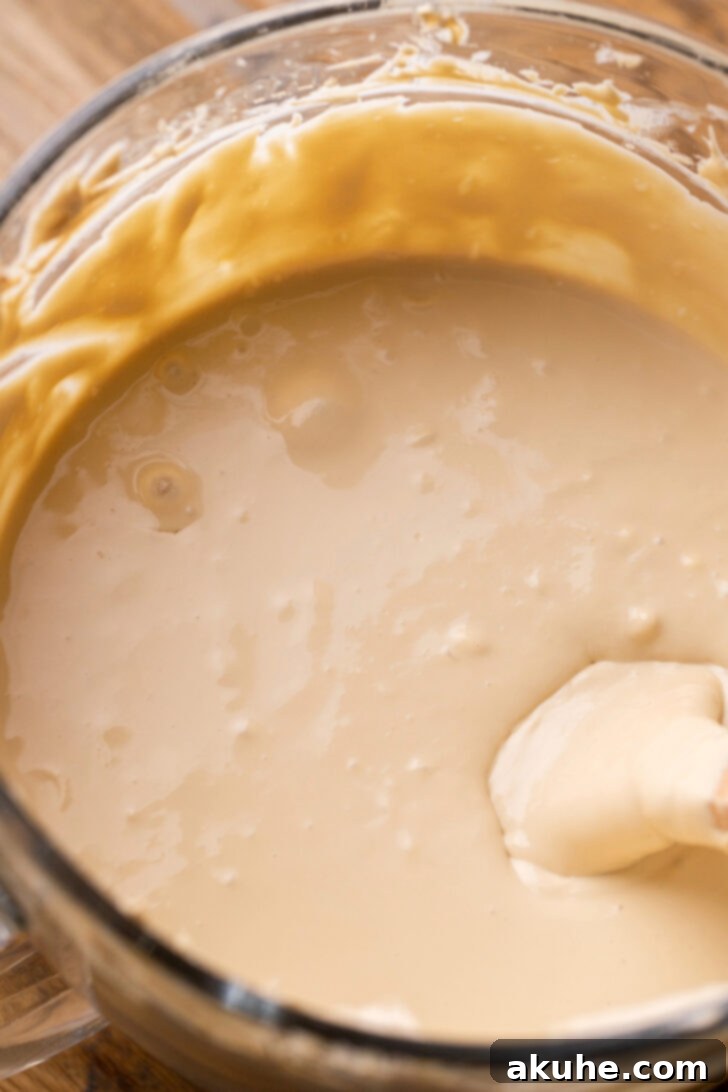
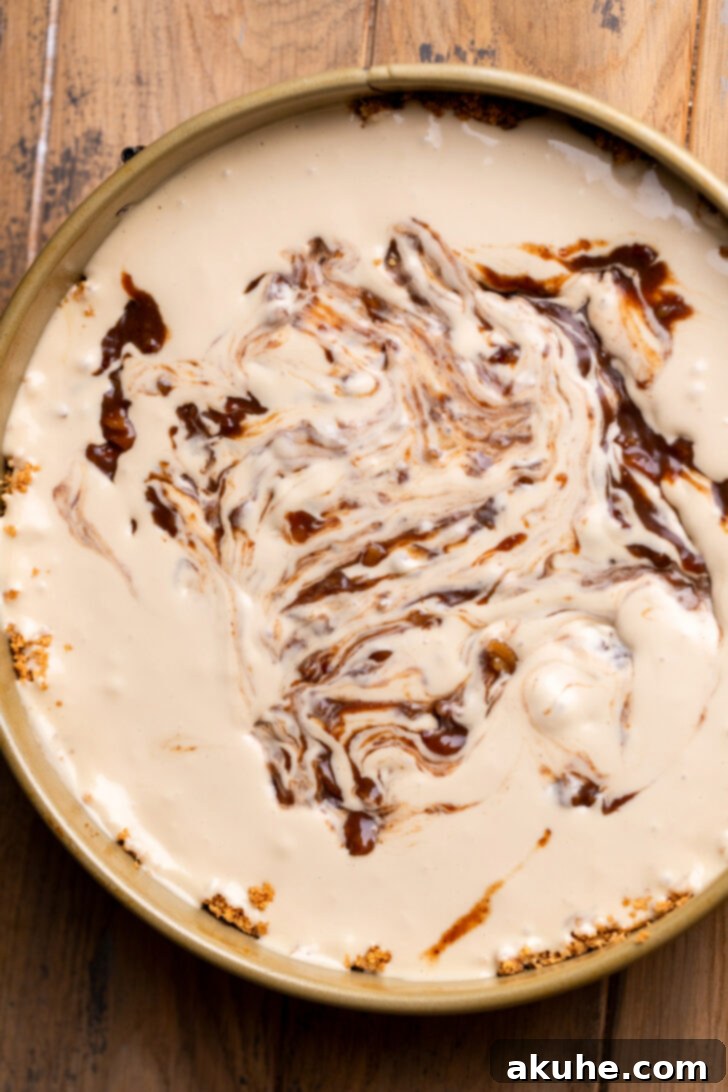
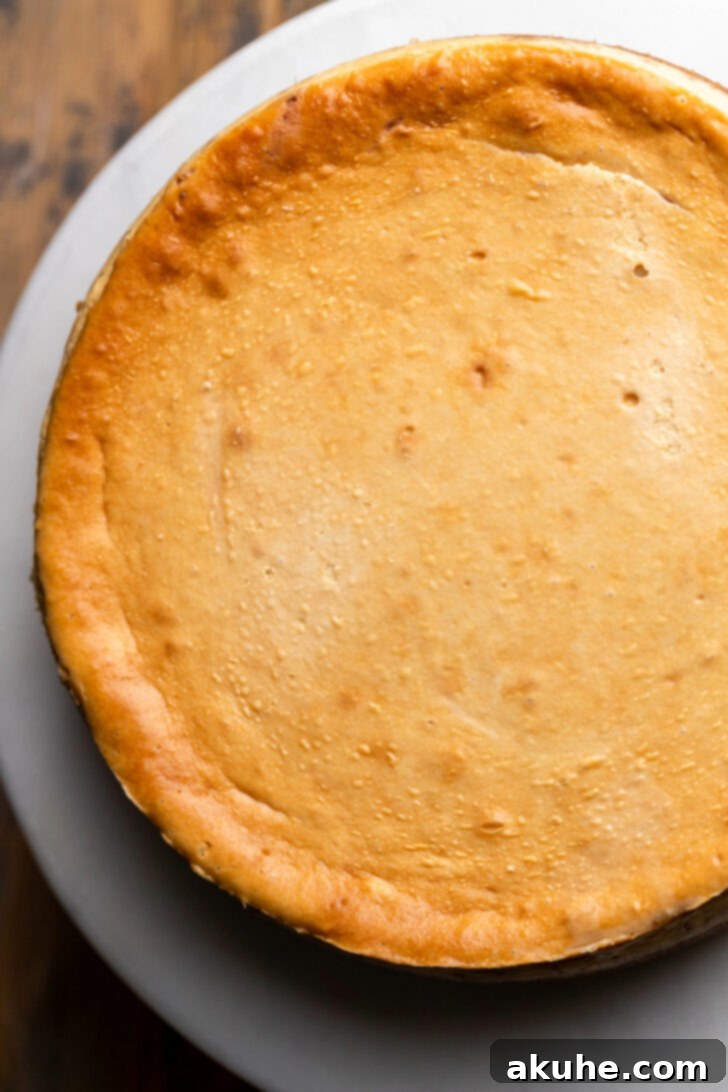
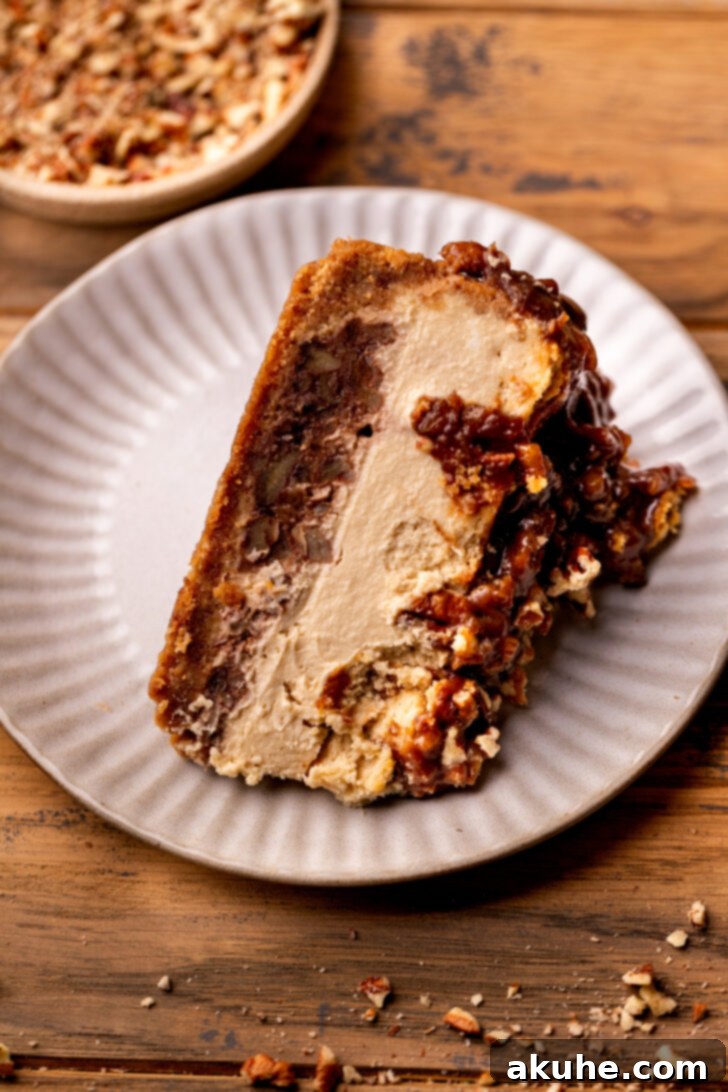
Key Ingredients & Their Role in Cheesecake Perfection
Understanding the role of each ingredient is vital for baking success, especially with a delicate dessert like cheesecake. Here’s a closer look at the key components of our Pecan Pie Cheesecake:
- Cream Cheese: Use full-fat, block-style cream cheese, not the spreadable kind from a tub. Ensure it’s at room temperature for at least two hours before mixing. This allows it to cream smoothly with the sugar, preventing lumps and creating a uniformly silky batter. Cold cream cheese will result in a lumpy texture, even after extensive mixing.
- Brown Sugar (Light or Dark): Brown sugar is critical for both the crust and the filling, and especially for the cheesecake batter. Its molasses content adds moisture, a caramel-like depth, and a beautiful, slightly darker hue that complements the pecan pie flavors. Dark brown sugar will lend a more robust, intense flavor profile than light brown sugar.
- Pecans: Quality pecans are non-negotiable. For the filling, chop them into small to medium pieces to ensure they are evenly distributed and provide a satisfying bite without being overly chunky. Larger pecan halves can be reserved for an elegant topping, if desired. Toasting your pecans lightly before use can also enhance their nutty flavor.
- Heavy Cream & Sour Cream: These dairy components contribute to the cheesecake’s luxurious texture. Heavy cream adds richness and helps create a smooth consistency, while sour cream introduces a delightful tang that balances the sweetness of the sugar and cuts through the richness of the cream cheese, preventing the cheesecake from tasting too heavy. Both should be at room temperature.
- Eggs: Eggs act as the primary binder and leavening agent, giving the cheesecake its structure. As mentioned in the tips, they must be at room temperature and mixed in gently to avoid cracks.
- Graham Cracker Crumbs & Unsalted Butter: The classic graham cracker crust offers a perfect counterpoint to the creamy filling. Using fine crumbs ensures a compact crust, and melted unsalted butter binds it together while adding a rich, buttery flavor.
- Ground Cinnamon & Vanilla Extract: These flavor enhancers are crucial for the overall aromatic profile. Cinnamon brings warmth and spice, enhancing the pecan and brown sugar notes, while pure vanilla extract elevates all the flavors, providing a comforting, familiar sweetness.
If you’re as passionate about pecans as we are, you’ll definitely want to explore more delicious pecan-inspired recipes! Don’t miss my pecan pie cinnamon rolls for a delightful breakfast or brunch treat, and my indulgent pecan pie cake, which is another incredible fusion of classic dessert flavors.
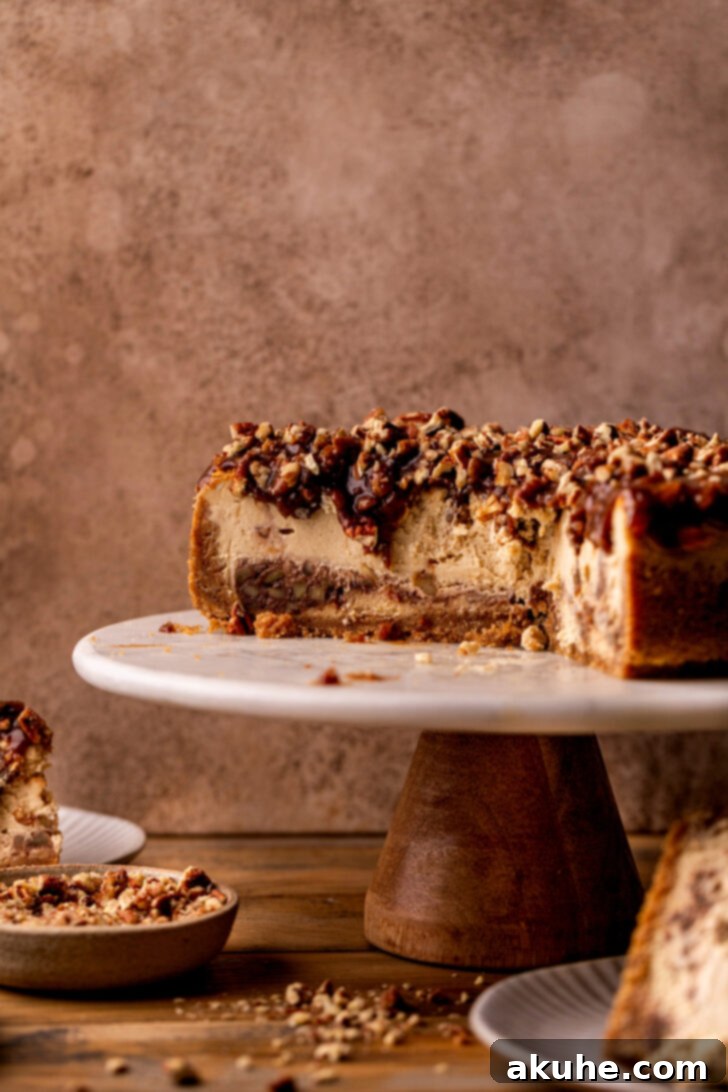
Did you adore this recipe? We’d love to hear your thoughts! Make sure to leave astar review and share your experience. Tag me on Instagram @stephaniesweettreats to show off your beautiful creations. For more baking inspiration and sweet ideas, be sure to follow me on Pinterest!
Pecan Pie Cheesecake Recipe
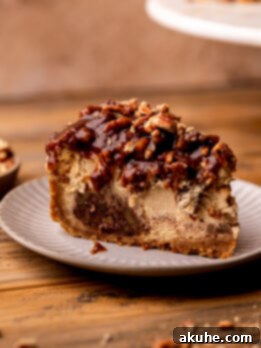
Rated 5 out of 5 stars by 13 reviewers
Pecan Pie Cheesecake
Print Recipe
Ingredients
Pecan Graham Cracker Crust
- 2 1/2 cups Graham cracker crumbs (equal to 2 full packets of graham crackers, fine crumb)
- 1/4 cup Brown sugar (packed, light or dark)
- 10 TBSP Unsalted butter (melted)
Cinnamon Pecan Pie Filling
- 10 TBSP Unsalted butter (melted)
- 1 1/2 cups Brown sugar (packed, light or dark)
- 2 tsp Ground cinnamon
- 1 1/2 cups Heavy cream
- 2 1/2 cups Pecans (chopped into larger pieces)
Brown Sugar Cheesecake
- 24 oz Cream cheese (room temperature)
- 3/4 cup Brown sugar (packed, light or dark)
- 1/2 cup Sour cream (room temperature)
- 1/2 cup Heavy cream (room temperature)
- 1 tsp Pure vanilla extract
- 4 Large eggs (room temperature)
Instructions
Graham Cracker Crust
- Preheat your oven to 325°F (160°C). Prepare a 9-inch springform pan by spraying it thoroughly with a non-stick baking spray. Place a 9-inch parchment paper circle at the bottom of the pan, then spray it again for extra non-stick insurance. Set this prepared pan aside.
- In a food processor or blender, blend the graham crackers until very fine crumbs are formed. In a medium bowl, combine these graham cracker crumbs with the brown sugar and melted unsalted butter. Mix with a fork until all the crumbs are evenly moistened by the butter, resembling wet sand.2 1/2 cups Graham cracker crumbs, 1/4 cup Brown sugar, 10 TBSP Unsalted butter
- Pour the crumb mixture into the prepared springform pan. Use your fingers to press the crust firmly onto the bottom of the pan and halfway up the sides. For a very compact and even crust, use the bottom of a flat measuring cup or glass to press it down firmly.
- Bake the crust in the preheated oven for 11 minutes. Once baked, remove it from the oven and allow it to cool completely on a wire rack while you prepare the filling and cheesecake batter.
Pecan Pie Filling
- While the crust is baking, begin preparing the cinnamon pecan pie filling. In a large saucepan over medium heat, melt the unsalted butter until fully liquid.10 TBSP Unsalted butter
- Add the brown sugar, ground cinnamon, heavy cream, and chopped pecans to the melted butter in the saucepan. Stir continuously and bring the mixture to a gentle bubble. Continue to cook, stirring occasionally, for 4-5 minutes. The mixture should thicken slightly but will still be liquidy.1 1/2 cups Brown sugar, 2 tsp Ground cinnamon, 1 1/2 cups Heavy cream, 2 1/2 cups Pecans
- Carefully separate the pecan pie filling into two equal bowls. Place one bowl in the freezer for about 20-30 minutes, or until it’s cool and slightly thickened but still pourable – this portion will be swirled into the cheesecake batter. Store the other half in the refrigerator until you are ready to use it as a topping for the baked and chilled cheesecake.
Brown Sugar Cheesecake Assembly and Baking
- Using an electric mixer (stand mixer with paddle attachment or a hand mixer), beat the room temperature cream cheese and brown sugar on high speed for approximately 2 minutes. Scrape down the sides of the bowl to ensure everything is well combined and smooth.24 oz Cream cheese, 3/4 cup Brown sugar
- Reduce the mixer speed to medium and add the room temperature sour cream, heavy cream, and pure vanilla extract. Mix until the batter is completely smooth and lump-free. Finally, add the room temperature eggs, one at a time, mixing on the lowest speed just until they are combined. Avoid overmixing once the eggs are added. Turn off the mixer and use a spatula to scrape the bottom and sides of the bowl one last time.1/2 cup Sour cream, 1/2 cup Heavy cream, 1 tsp Pure vanilla extract, 4 Large eggs
- Pour half of the cheesecake batter into the cooled graham cracker crust. Take the chilled half of the pecan pie filling from the freezer and spoon dollops over the cheesecake batter. Using a butter knife or a skewer, gently swirl the pecan filling into the cheesecake batter to create a marbled effect. Be careful not to disturb the crust too much. Carefully pour the remaining cheesecake batter over the swirled filling.
- Prepare your water bath: For the safest method, use a large roasting pan (about 12×16 inches) and hot boiling water.
1. Place your 9-inch springform pan (with the cheesecake) inside a slightly larger 10-inch cake pan. Then, place this assembly into the large roasting pan. Carefully fill the roasting pan with hot boiling water until it reaches about two-thirds up the side of the 10-inch cake pan. This method is highly recommended as it prevents any water from potentially seeping into the cheesecake crust.
2. Alternatively, if not using a second cake pan, wrap your springform pan tightly with two layers of heavy-duty aluminum foil to create a waterproof seal. Place the wrapped pan directly into the roasting pan and fill with hot boiling water about halfway up the sides of the springform pan.
- Carefully transfer the roasting pan with the cheesecake into your preheated 325°F (160°C) oven. Bake for 65-85 minutes. The cheesecake is done when the edges are set and appear slightly puffed, but the very center still has a slight, gentle jiggle when the pan is lightly shaken. If the center has a significant wobble, bake for an additional 10 minutes and check again.
- Once baked, turn off the oven but leave the cheesecake inside. Prop the oven door open slightly with a wooden spoon and allow the cheesecake to cool gradually in the warm oven for 30 minutes. This slow cooling helps prevent cracks. After 30 minutes, carefully remove the cheesecake from the water bath and place it on a wire cooling rack. Allow it to cool completely at room temperature. Once cooled, wrap the springform pan tightly with aluminum foil and transfer it to the refrigerator. Chill for at least 6 hours, or ideally, overnight, for the best texture and flavor.
- After the cheesecake is completely chilled, carefully release the springform pan sides. Gently slide the cheesecake off the pan bottom and remove the parchment paper from the crust.
- Before serving, retrieve the remaining pecan pie filling from the refrigerator. Warm it slightly if needed to make it pourable, then spoon it generously over the top of the chilled cheesecake.
Notes
Nutrition Information (per serving):
- Calories: 684kcal
- Carbohydrates: 50g
- Protein: 6g
- Fat: 53g
- Saturated Fat: 26g
- Polyunsaturated Fat: 5g
- Monounsaturated Fat: 17g
- Trans Fat: 1g
- Cholesterol: 118mg
- Sodium: 242mg
- Potassium: 231mg
- Fiber: 2g
- Sugar: 40g
- Vitamin A: 1500IU
- Vitamin C: 0.4mg
- Calcium: 125mg
- Iron: 1mg
Did you make this recipe?
Please leave a star rating and review below!
Serving Suggestions & Storage Tips
Once your Pecan Pie Cheesecake is perfectly chilled and topped with that glistening pecan filling, it’s ready to be the star of your dessert table. For an extra touch of elegance, consider serving each slice with a dollop of freshly whipped cream, a scoop of vanilla bean ice cream, or a light dusting of cinnamon. The richness of the cheesecake pairs beautifully with a strong cup of coffee or a comforting mug of hot chocolate, especially during the colder months.
To store any leftovers, place individual slices or the remaining whole cheesecake in an airtight container. It will keep well in the refrigerator for up to 4-5 days. For longer storage, you can freeze individual slices, wrapped tightly in plastic wrap and then aluminum foil, for up to 1-2 months. Thaw frozen cheesecake in the refrigerator overnight before serving. The crust may soften slightly after freezing, but the flavors will remain wonderfully intact.
Common Cheesecake Troubleshooting
Even experienced bakers can encounter cheesecake challenges. Here are solutions to a few common issues:
- Cracked Surface: The most common culprit is overbaking, overmixing the eggs, or rapid temperature changes. Ensure your water bath is used correctly, avoid opening the oven door too frequently, and allow the cheesecake to cool gradually inside the oven as per instructions. If a small crack appears, don’t fret – your pecan pie topping will beautifully conceal it!
- Soggy Crust: This usually happens if the springform pan isn’t properly sealed in the water bath or if the crust wasn’t baked sufficiently. Using the trick of placing the springform pan inside a larger cake pan for the water bath is the best defense against a soggy crust. Make sure your initial crust bake is solid.
- Unset Center: If the cheesecake is still too jiggly after the recommended baking time, it simply needs more time. Continue baking in 10-minute increments until the edges are set and the center has a slight, custard-like wobble. Ensure your oven temperature is accurate.
- Lumpy Batter: This is almost always due to cold cream cheese or overmixing. Ensure all dairy ingredients are at room temperature and beat the cream cheese and sugar until perfectly smooth before adding other ingredients.
Frequently Asked Questions About Pecan Pie Cheesecake
Here are answers to some common questions you might have about making this delicious dessert:
Q: Can I use pre-made graham cracker crust?
A: While a pre-made crust can save time, the homemade pecan graham cracker crust in this recipe adds an unparalleled depth of flavor and texture that truly elevates the cheesecake. It’s highly recommended for the best results.
Q: What if I don’t have a springform pan?
A: A springform pan is ideal for cheesecakes because of its removable sides, which allow for easy unmolding without damaging the delicate structure. While you could theoretically bake in a regular cake pan, removal would be very challenging and might damage the cheesecake. It’s worth investing in a springform pan if you plan to make cheesecakes regularly.
Q: Can I make this cheesecake ahead of time?
A: Absolutely! Cheesecake is an excellent make-ahead dessert. In fact, chilling it overnight is crucial for its texture and flavor to fully develop. You can prepare it 1-2 days in advance and keep it refrigerated. Add the topping just before serving.
Q: Is dark brown sugar essential, or can I use light?
A: While light brown sugar can be used, dark brown sugar is recommended as it contributes a richer, more pronounced molasses flavor which perfectly complements the deep notes of pecan and cinnamon. It enhances the overall “pecan pie” experience within the cheesecake.
Q: How do I know when the cheesecake is perfectly baked?
A: Look for edges that are set and slightly puffed, while the very center (about 2-3 inches in diameter) still has a slight, soft wobble. It should resemble a firm custard. The residual heat will continue to cook it as it cools.
